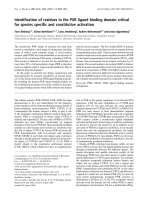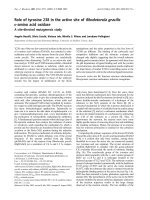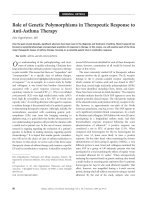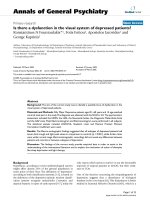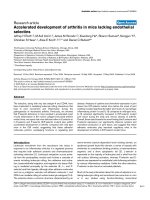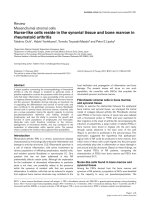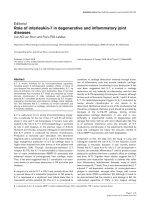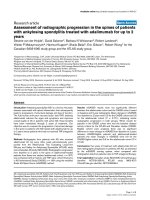Báo cáo y học: "Science review: Genetic variability in the systemic inflammatory response" pdf
Bạn đang xem bản rút gọn của tài liệu. Xem và tải ngay bản đầy đủ của tài liệu tại đây (76.25 KB, 7 trang )
308
ARDS = acute respiratory distress syndrome; bp = base pair; HLA = human leukocyte antigen; IL = interleukin; IL-1Ra = interleukin-1 receptor
antagonist; LPS = lipopolysaccharide; LT-α = lymphotoxin-α; SNP = single nucleotide polymorphism; SP = surfactant protein; TLR = Toll-like
receptor; TNF = tumor necrosis factor.
Critical Care August 2003 Vol 7 No 4 Waterer and Wunderink
The fact that individual genetic differences impact on the risk
for developing or dying from various diseases has long been
accepted. Typical examples include sickle cell trait and
malaria, BRCA2 mutations and breast carcinoma, and trinu-
cleotide repeats and a variety of neurologic diseases, includ-
ing Huntington disease.
Physicians have also long been aware of the markedly differ-
ent responses of seemingly similar individuals to the same
inflammatory or infectious agents. The role of individual
genetic differences as an explanation for these observations
has been the subject of much speculation. The strongest
observational evidence of a genetic influence comes from a
study conducted by Sorenson and colleagues [1]. In their
study of adoptees, the death of a biologic parent from infec-
tion was associated with a five times greater risk for death
from infection. During the past half-decade, advances in
knowledge of the human genome, greater understanding of
the inflammatory response, and the development of genotyp-
ing technologies have allowed us to start the process of iden-
tifying specific genetic mutations associated with different
inflammatory phenotypes.
In the present review, we discuss recent studies that have
identified genetic differences in inflammatory proteins that are
associated with different phenotypic presentations of system
inflammation.
Basic genetic terminology
A region of DNA that encodes a protein product is called an
exon. Introns are the noncoding regions of DNA that separate
exons. Most genes consist of several exons and introns. The
rate at which genes are transcribed is controlled by a variety
of nuclear proteins that bind to different areas of DNA in the
5′ (upstream) region from the first exon. The segment of DNA
that controls the regulation of transcription of a gene is
known as the promoter region.
Review
Science review: Genetic variability in the systemic inflammatory
response
Grant W Waterer
1
and Richard G Wunderink
2
1
Senior Lecturer in Medicine, Department of Medicine, University of Western Australia, Australia
2
Director, Research Department, Methodist Le Bonheur Healthcare, Memphis and Clinical Associate Professor, University of Tennessee, Memphis,
Tennessee, USA
Correspondence: Richard G Wunderink,
Published online: 4 April 2003 Critical Care 2003, 7:308-314 (DOI 10.1186/cc2164)
This article is online at />© 2003 BioMed Central Ltd (Print ISSN 1364-8535; Online ISSN 1466-609X)
Abstract
The present review discusses recent studies that have identified genetic differences in inflammatory
proteins associated with different phenotypic presentations of systemic inflammation. Basic genetic
terminology is defined. Implications of genetic influences on the inflammatory response are discussed.
The published associations of specific polymorphisms in antigen recognition pathways,
proinflammatory cytokines, anti-inflammatory cytokines, and effector molecules are reviewed. The
strongest and most consistent associations thus far have been with the tumor necrosis factor,
lymphotoxin-α, and IL-1 receptor antagonist polymorphisms. However, large, phenotypically detailed
studies are required to address all of the other potential polymorphisms in inflammatory molecule
genes and their interactions.
Keywords gene polymorphisms, genetics, inflammation, pneumonia, sepsis
309
Available online />A variety of mutations can occur in DNA, some of which lead to
a change in function or production of a gene product. The sim-
plest change is the substitution of one nucleotide for another,
which is known as a single nucleotide polymorphism (SNP). A
number of other mutations occur, including deletion or insertion
of one or more nucleotides, and insertion of multiple repeating
sequences (e.g. the trinucleotide repeats mentioned above).
Mutations that occur in an exon may lead to a change in the
protein structure encoded by the gene. Changes that occur in
a promoter region may alter the binding of a transcription acti-
vating or suppressing factor, altering the rate of transcription of
the gene. Although introns were considered to be ‘junk DNA’,
and consequently mutations in introns were believed to be
unimportant biologically, it is now appreciated that polymor-
phisms within introns can affect gene regulation, particularly
when near the intron–exon boundary [2,3].
SNPs are referred to by their distance (i.e. the number of bp
away) from the transcription activating site. Therefore, gene X
-505 indicates that the SNP is 505 bp upstream of the
X gene, potentially in the promoter region. Gene X +505 indi-
cates the SNP is 505 bp downstream of the transcription
activating site, potentially in an exon or intronic region.
Variations in a gene that arise due to mutations are referred to
as alleles. An individual’s genotype is often referred to by the
nucleotide carried at the polymorphic site in question (i.e.
tumor necrosis factor [TNF]-α-308A or TNF-α-308G). An
alternative nomenclature is sometimes used when a mutation
causes an amino acid change in the protein (i.e. Toll-like
receptor [TLR]-4 Thr399Ile indicates an isoleucine is substi-
tuted for a threonine at amino acid position 399). Finally, the
most common allele can be referred to as allele 1 (or A), the
second most common as allele 2 (or B), and so on (i.e.
TNF-α-308 allele 1). Because allele frequencies can vary sig-
nificantly between populations, the latter convention for
naming has the potential to lead to considerable confusion,
and we therefore avoid that convention wherever possible in
the present review.
The inflammatory response
Following the recognition of foreign antigens, a variety of
proinflammatory cytokines are released, along with counter-
regulatory or anti-inflammatory cytokines. Genetic polymor-
phisms with potential influences on the inflammatory
response have been identified in a variety of antigen recogni-
tion pathways, proinflammatory cytokines, and anti-inflamma-
tory cytokines (Table 1).
The outcome of an inflammatory response is dictated by a
variety of factors, including the pathogenicity and duration of
the stimulus, and the balance between the proinflammatory
and anti-inflammatory response. An excessive proinflamma-
tory (or deficient anti-inflammatory) response is thought to be
important in the pathogenesis of septic shock [4]. Equally, a
deficient proinflammatory (or excessive anti-inflammatory)
response could result in failure to clear an invading pathogen,
with equally deleterious effects. A further adverse result of the
anti-inflammatory response is the period of relative immuno-
suppression (also known as immunoparalysis or compen-
satory anti-inflammatory response syndrome [4]) after an
inflammatory insult. Prolonged compensatory anti-inflamma-
tory response syndrome may be associated with excess mor-
tality and morbidity because of increased risk for nosocomial
infections [5].
With substantial overlap between the functions of many
cytokines, and frequently multiple antagonists for any given
agonist, the ability to compensate for a certain amount of
divergence in production of individual cytokines is significant.
Therefore, for a single mutation to influence the outcome of
an inflammatory response, the mutation must markedly alter
Table 1
An enormous number of genes have been identified as having
potentially important polymorphic sites
Sites of specific polymorphism Gene
Antigen recognition pathways CD14
TLR-4
TLR-2
HSP-70-1
HSP-70-2
HSP-70-HOM
Proinflammatory cytokines TNF-α + receptors
IL-1α + IL-1β + receptors
IL-6, IL-2, IL-3,
IL-8 + receptors
IFN-γ
IL-12
IL-18
GM-CSF
IFN-α
LT-α
Anti-inflammatory cytokines IL-10
IL-1Ra
IL-13
TGF-β
1
and TGF-β
2
IL-4
CTLA-4
CTLA, cytotoxic T-lymphocyte-associated antigen; GM-CSF,
granulocyte/macrophage colony-stimulating factor; HSP, heat shock
protein; IFN, interferon; IL-1Ra, interleukin 1 receptor antagonist; LT,
lymphotoxin; TGF, transforming growth factor; TLR, Toll-like receptor;
TNF, tumor necrosis factor.
310
Critical Care August 2003 Vol 7 No 4 Waterer and Wunderink
the production or function of a critical inflammatory protein.
Although possible, a more likely scenario is the inheritance of
multiple mutations in multiple proteins, each leading to small
changes in production or function, but with a net serious
deleterious effect.
Finally, for seemingly adverse mutations to be preserved in
the human genome despite predisposition to a deleterious
outcome in one disease, a survival advantage in another (i.e.
different infection, malignancy, etc.) is quite possible. The
sickle cell–malaria relationship is the most obvious example.
Many of the polymorphisms described in this review were first
studied in noninfectious or non-critical-care populations. A
consistent relationship in these other inflammatory disorders
adds to the validity of findings in the critically ill. Therefore,
although identifying polymorphisms associated with adverse
outcomes can provide useful insights into the inflammatory
response, much more study will be needed before the full
implications of carriage of specific polymorphisms in specific
individuals can be determined.
The specific mutations in the systemic inflammatory response
can be roughly grouped for discussion into three categories:
antigen recognition, proinflammatory cytokines, and anti-
inflammatory cytokines.
Antigen recognition pathways
CD14
CD14 is a glycosylphosphatidylinositol membrane-anchored
protein that is expressed on the surface of macrophages,
monocytes, and polymorphonuclear cells. Complexed with
two other proteins, namely MD-2 and TLR-4, CD14 has been
identified as a key endotoxin, or lippopolysaccharide (LPS)
recognition pathway [6]. A second, CD14-independent LPS
recognition pathway has also been identified that involves a
complex of heat shock protein-70, heat shock protein-90,
chemokine receptor-4, and growth differentiation factor-5 [7].
A polymorphism at -159 involving a cytosine to thymidine tran-
sition has been identified in the CD14 gene [8], with those who
carry the T allele having greater circulating levels of soluble
CD14. Because transgenic mice that over-express CD14 are
highly susceptible to septic shock [9], increased expression of
CD14 may be an important risk factor for septic shock. Gibot
and colleagues [10] recently found that carriage of the CD14 -
159 TT genotype was more common in 90 French patients
with septic shock than in 122 age- and sex-matched, healthy
control individuals (71% versus 48%; P = 0.008). Currently
clinical trials of CD14 blocking agents are underway. However,
increased mortality from Gram-negative infections in animals
treated with anti-CD14 antibodies [11] suggests that therapeu-
tic intervention may potentially be limited.
Toll-like receptors
One of the most important recent discoveries of mechanisms
of foreign antigen recognition is the identification of the group
of proteins known as the TLRs. Toll protein was initially rec-
ognized in Drosophila as an important signaling molecule in
innate immunity against bacteria and fungi. Thus far, 10 TLRs
have been identified in humans [12]. TLR-4 appears to be
essential for signal recognition of LPS, whereas TLR-2
appears to be vital for recognition of peptidoglycans from
Gram-positive bacteria [12].
Mice with a mutation in TLR-4 are highly resistant to LPS chal-
lenge [13], and several coding region variations in human
TLR-4 have been identified [14], although their functional
importance is as yet undetermined. Lorenz and colleagues [15]
studied the TLR-4 Asp299Gly and TLR-4 Thr399Ile mutations
in a French cohort of 91 patients with septic shock and
73 healthy control individuals. Interestingly, carriage of TLR-4
Asp299Gly was found only in the shock cohort (P = 0.05),
although a potential confounding factor was a significant differ-
ence in the age of the control individuals (mean 37 years) as
compared with cases (mean 58 years; P< 0.001). Although
further studies are needed, the authors speculated that the
TLR-4 Asp299Gly mutation may interrupt LPS signaling.
Consistent with its important role in the recognition of Gram-
positive bacteria, a TLR-2 mutation (Arg753Gln) was found
to be associated with a reduced inflammatory response to
Borrelia burgdorferi and Treponema pallidum [16]. In the
same cohort as the TLR-4 study above [15], the TLR-2
Arg753Gln mutation was found in only two individuals. Both
had staphylococcal sepsis, which is consistent with this
mutation predisposing to Gram-positive sepsis.
Proinflammatory cytokines
Tumor necrosis factor-
αα
TNF-α is a critical cytokine in the inflammatory response to
infection [17]. Accordingly, any genetic variability in the pro-
duction of TNF-α after an infectious stimulus could have a
significant impact on the degree of inflammatory response
and therefore potentially influence the clinical outcome.
In vitro studies have consistently found marked individual vari-
ation in TNF-α production after a variety of inflammatory
stimuli [18–21]. Early studies identified specific human leuko-
cyte antigen (HLA) markers associated with variable TNF-α
production (e.g. HLA A1B8DR3 haplotype in Caucasians
[22]). Subsequently, the highly polymorphic nature of the TNF
locus has become appreciated, with more than a dozen
SNPs and several microsatellites (areas of multiple
nucleotide repeat sequences) being described.
A significant amount of evidence supports the biologic impor-
tance of polymorphisms within the TNF-α promoter region. A
guanine (G) to adenine (A) transition at TNF-α-308, associ-
ated with the ancestral haplotype mentioned above [22], is
perhaps the best studied cytokine polymorphism and the one
for which the best evidence of functional significance exists.
Stimulation studies in healthy volunteers suggested that car-
311
riage of the TNF-α-308 A allele is associated with signifi-
cantly greater TNF-α production [23] and TNF-α mRNA tran-
scription [24], although the degree of difference may be
depend on the cell type stimulated and the stimulus applied
[25]. Carriage of the A allele of TNF-α-308 has been associ-
ated with an increased risk for many diseases, including
septic shock [26], severe cerebral malaria [27], and death
from meningococcal sepsis [28].
Additional polymorphisms within the TNF-α promoter may also
influence the rate of transcription of TNF-α, including TNF-α-
238 [29], TNF-α-376 [30], and TNF-α-1031 [31]. Clinical
association studies suggest mutations at TNF-α-376 are risk
factors for severe malaria [30] and mutations at TNF-α-238
are risk factors for death from community-acquired pneumonia
[32], although not from meningococcal sepsis [33].
Complicating assessment of TNF-α polymorphisms is the high
degree of linkage disequilibrium between TNF-α promoter poly-
morphisms and between other polymorphisms within other
nearby genes, many of which also have significant inflammatory
roles. Although not a comprehensive list, among the nearby
genes (Fig. 1) are many with major inflammatory roles, including
lymphotoxin-α (LT-α), lymphotoxin-β, the heat shock protein-70
complex, complement 4A and 4B, HLA B associated
transcript 1, and the HLA A, B, C, DR, DP, and DQ loci.
Lymphotoxin-
αα
(also known as tumor necrosis factor-
ββ
)
LT-α +250, a G to A transition in the first intron of LT-α, has
been identified as a potentially influential locus in many
inflammatory conditions. This polymorphism is part of a
complex haplotype including the nonsynonymous mutation
LT-α +250 Asp26Thr. Linkage disequilibrium with the TNF-α-
308G allele and the LT-α +250 A allele [34] requires that
these polymorphisms not be assessed in isolation. Carriage
of the A allele of LT-α +250 has been associated with
increased TNF-α production both in vitro [35] and in vivo
[36,37], providing a biologically plausible mechanism of
effect, although the mechanism by which this mutation
impacts on TNF-α production is unknown.
In the landmark study of 40 patients with septic shock con-
ducted by Stuber [36], carriage of the LT-α +250 AA geno-
type carried a substantially greater risk for death (P = 0.002).
Subsequent studies by the same group suggested that car-
riage of LT-α +250 A is also a risk factor for the development
of septic shock, at least in a population of 110 post-trauma
patients [37]. We have also found LT-α +250 AA genotype
to be a risk factor for septic shock in patients with commu-
nity-acquired pneumonia [34]. Interestingly, respiratory failure
in the absence of shock strongly correlated with TNF-α +250
GG genotype, again suggesting that polymorphisms may be
‘good’ or ‘bad’, depending on the outcome of interest.
Interleukin-1
αα
and interleukin-1
ββ
IL-1, a potent proinflammatory cytokine released by
macrophages, also plays a key role in mediating endotoxin
lethality [38]. The IL-1 family includes the agonists IL-1α and
IL-1β, and the IL-1 receptor antagonist (IL-1Ra). Although
both the IL-1β +3953 and -511 polymorphic sites may influ-
Available online />Figure 1
Area in short arm of chromosome 6, demonstrating the close proximity of many genes that are involved in inflammatory responses within the human
leukocyte antigen (HLA) locus.
~4Mb
TNFA
LTA
IKBL
BAT1
ACB
LTB
HSP70-1
HSP70-Hom
HSP70-2
DP
DQ DR
C2
Bf
C4A
C4B
RAGE
HOX12
TAP2
TAP1
LMP2
LMP7
LST-1
CKII
312
ence levels of IL-1β in stimulated peripheral blood mononu-
clear cells [39], no association was found with susceptibility to
or outcome from septic shock by Fang and colleagues [40].
Kornman and coworkers [41] did find an association between
IL-1β +3953 and risk for periodontitis, and so an effect of
these polymorphisms on the inflammatory response in some
conditions remains possible, but as yet not demonstrated.
Interleukin-6
IL-6 has been demonstrated to be a marker of the severity
and outcome of sepsis by a number of groups, but whether
this is an epiphenomenon or a more causative relationship is
still undetermined. A haplotype involving at least four SNPs
within the promoter has been identified and appears to influ-
ence the rate of transcription of IL-6 [42]. Schluter and col-
leagues [43] studied the IL-6 -174 C/G polymorphism – one
of the SNPs in this haplotype – in 50 German patients with
severe sepsis; they found that carriage of the IL6 -174 GG
(low IL-6 secretor phenotype) genotype was associated with
improved survival.
A common problem in interpreting the finding of an associa-
tion between a polymorphism and a clinical outcome is
demonstrated in the study conducted by Schluter and col-
leagues [43]. Despite the positive findings discussed above,
no correlation was found between serum IL-6 levels and IL-6
-174 genotype. One interpretation of the lack of a pheno-
type–genotype correlation would be that the association is
spurious. However, serum cytokine levels may have a poor
correlation with tissue concentrations, and a single serum
level taken at a variable time point after the onset of the
inflammatory insult may tell us little about the amount of IL-6
produced in the early critical phases of the inflammatory
response. Much greater research into genotype–phenotype
relationships and how they are altered by external factors
(such as comorbid diseases) is clearly required.
Anti-inflammatory cytokines
Interleukin-1 receptor antagonist
As already mentioned, IL-1Ra is part of the IL-1 family of pro-
teins and, as its name suggests, is a naturally occurring
antagonist of IL-1α and IL-1β. IL-1Ra knockout mice have
increased susceptibility to endotoxin-induced lethality
whereas mice that over-express IL-1Ra are protected [44],
indicating that IL1-Ra is likely to play a key role in protection
against the adverse effects of an inflammatory response.
Intron 2 of IL-1Ra contains a variable 86-bp tandem repeat
containing at least three binding sites for DNA-binding pro-
teins [45]. Alleles are named A1, A2, A3, A4, and A5, based
on their relative frequency in healthy populations. In vitro
studies suggest that fewer 86-bp repeats correlates with
higher IL-1Ra protein production after LPS stimulation [46].
The relationship appears to be complex, with higher IL-1Ra
found in the serum of healthy A2 allele carriers [46,47] but
only in those who also carry the high IL-1β genotype of IL-1β -
511 [47]. Carriage of the A2 allele has been associated with
increased risk for a number of inflammatory disorders, including
systemic lupus erythematosis, Sjögren’s syndrome, myasthenia
gravis, alopecia areata, Grave’s disease, periodontitis,
Henoch–Schönlein nephritis, multiple sclerolis, ulcerative colitis,
tuberculous pleurisy and insulin-dependent diabetes mellitus.
In 93 patients with severe sepsis, Fang and colleagues [40]
found carriage of the A2 allele to be associated with a signifi-
cantly greater risk for septic shock, with carriage of both the
LT-α +250 AA and IL-1Ra A2/A2 genotypes universally fatal.
Ma and colleagues [48] recently confirmed these findings in a
study of 60 Chinese patients with severe sepsis, and Arnalich
and colleagues [49] also demonstrated a 6.47-fold increased
risk for death in IL-1Ra A2 carriers in a cohort of 78 Spanish
patients with severe sepsis. Taken together, the weight of evi-
dence would certainly suggest that this IL-1Ra locus has a very
influential effect on the outcome of an inflammatory response.
Interleukin-10
IL-10 is also a potent anti-inflammatory protein. In a study of
LPS stimulated whole blood, Westendorp and colleagues
[33] found that family members of children who died from
meningococcemia had significantly greater IL-10 production
than did family members of children who survived. This sug-
gests that genetic differences in IL-10 production are likely to
be important in the outcome of severe sepsis.
Several polymorphisms have been identified in IL-10, includ-
ing a three-SNP promoter haplotype [50], and microsatellites
in both the 3′ and 5′ regions [51,52]. The promoter haplotype
influences IL-10 production, with stimulated lymphocytes
from individuals carrying IL-10 -1082A/-819C/-592C haplo-
type producing less IL-10 after concanavalin A stimulation
than those carrying the 1082G/-819C/-592C haplotype [50].
A variety of inflammatory diseases have been associated with
IL-10 SNP promoter genotypes, including asthma severity,
inflammatory bowel disease, rheumatoid arthritis, and sys-
temic lupus erythematosus. The only published study of IL-10
genotype and severe sepsis to date found that the -1082 GG
genotype was associated with a greater risk for meningococ-
cal disease [53]. The -1082 GG genotype also appears to be
a risk factor for chronic hepatitis C [54]. Further studies in
severe sepsis are awaited.
Other proteins
Outside of the three broad groups of proteins detailed above
are a large number of genes that may modify the outcome of
a systemic inflammatory insult. Many of these genes encode
proteins that are upregulated or downregulated by the inflam-
matory response, key examples of which include the coagula-
tion system and tissue and wound repair. In some cases,
gene mutations in the ‘downstream’ proteins may have a
much greater impact than mutations in genes expressed early
in the inflammatory response.
Critical Care August 2003 Vol 7 No 4 Waterer and Wunderink
313
Studies of acute respiratory distress syndrome (ARDS),
which is known to be associated with a marked inflammatory
response [55,56], demonstrate the potential role of mutations
within genes outside the inflammatory system. Homozygotes
for the deletion allele of the angiotensin converting enzyme
deletion/insertion polymorphism were markedly (P < 0.0001)
over-represented in a cohort of patients with ARDS in the UK
[57]. This angiotensin converting enzyme polymorphism has
been associated with a wide arrange of predominantly vascu-
lar diseases, and the study conducted by Marshall and col-
leagues [57] suggests that the renin–angiotensin system may
play a key role in the pathogenesis of ARDS.
An entirely different set of polymorphisms within the surfac-
tant protein (SP)-A, SP-B, and SP-D genes has also been
studied in patients with ARDS. In a case–control study, Lin
and colleagues [58] found carriage of the SP-B +1580 C
allele (which is associated with a change of isoleucine to
threonine at amino acid 131) was associated with a 2.4 times
increased risk for ARDS. Because SPs are known to be
important in a number of pulmonary processes, including
local host defense and modulating pulmonary inflammation,
the association is biologically plausible.
Conclusion
An increasing array of polymorphisms in diverse inflammatory
genes have been identified as candidates to explain part of the
enormous phenotypic variability in the systemic inflammatory
response. Currently published studies, although illuminating,
are already inadequate to assess the relative influence of and
interactions between the currently identified loci. Large, phe-
notypically detailed studies, with adequate statistical power to
address these issues are now required. Clearly, the size of
these studies will be beyond a single institution and will
require large, multicenter, collaborative efforts. Despite the
size and complexity of the task, enormous potential to develop
new therapeutic interventions is clearly possible once we
understand and can predict individual inflammatory responses.
Competing interests
RGW is a consultant for and receives research support from
Genomics Collaborative.
References
1. Sorensen TI, Nielsen GG, Andersen PK, Teasdale TW: Genetic
and environmental influences on premature death in adult
adoptees. N Engl J Med 1988, 318:727-732.
2. Li M, Pritchard PH: Characterization of the effects of mutations
in the putative branchpoint sequence of intron 4 on the splic-
ing within the human lecithin:cholesterol acyltransferase
gene. J Biol Chem 2000, 275:18079-18084.
3. Artiga MJ, Saez AI, Romero C, Sanchez-Beato M, Mateo MS,
Navas C, Mollejo M, Piris MA: A short mutational hot spot in the
first intron of BCL-6 is associated with increased BCL-6
expression and with longer overall survival in large B-cell lym-
phomas. Am J Pathol 2002, 160:1371-1380.
4. Bone RC: Sir Isaac Newton, sepsis, SIRS, and CARS. Crit Care
Med 1996, 24:1125-1128.
5. Peters M, Petros A, Dixon G, Inwald D, Klein N: Acquired
immunoparalysis in paediatric intensive care: prospective
observational study. BMJ 1999, 319:609-610.
6. Triantafilou M, Triantafilou K: Lipopolysaccharide recognition:
CD14, TLRs and the LPS-activation cluster. Trends Immunol
2002, 23:301-304.
7. Triantafilou K, Triantafilou M, Dedrick RL: A CD14-independent
LPS receptor cluster. Nat Immunol 2001, 2:338-345.
8. Baldini M, Lohman IC, Halonen M, Erickson RP, Holt PG, Martinez
FD: A polymorphism* in the 5
′′
flanking region of the CD14
gene is associated with circulating soluble CD14 levels and
with total serum immunoglobulin E. Am J Respir Cell Mol Biol
1999, 20:976-983.
9. Ferrero E, Jiao D, Tsuberi BZ, Tesio L, Rong GW, Haziot A,
Goyert SM: Transgenic mice expressing human CD14 are
hypersensitive to lipopolysaccharide. Proc Natl Acad Sci USA
1993, 90:2380-2384.
10. Gibot S, Cariou A, Drouet L, Rossignol M, Ripoll L: Association
between a genomic polymorphism within the CD14 locus and
septic shock susceptibility and mortality rate. Crit Care Med
2002, 30:969-973.
11. Frevert CW, Matute-Bello G, Skerrett SJ, Goodman RB, Kajikawa
O, Sittipunt C, Martin TR: Effect of CD14 blockade in rabbits
with Escherichia coli pneumonia and sepsis. J Immunol 2000,
164:5439-5445.
12. Lien E, Ingalls RR: Toll-like receptors. Crit Care Med 2002, 30
(suppl):S1-S11.
13. Poltorak A, He X, Smirnova I, Liu MY, Van Huffel C, Du X, Birdwell
D, Alejos E, Silva M, Galanos C, Freudenberg M, Ricciardi-
Castagnoli P, Layton B, Beutler B: Defective LPS signaling in
C3H/HeJ and C57BL/10ScCr mice: mutations in Tlr4 gene.
Science 1998, 282:2085-2088.
14. Beutler B, Du X, Poltorak A: Identification of Toll-like receptor 4
(Tlr4) as the sole conduit for LPS signal transduction: genetic
and evolutionary studies. J Endotoxin Res 2001, 7:277-280.
15. Lorenz E, Mira JP, Frees KL, Schwartz DA: Relevance of muta-
tions in the TLR4 receptor in patients with gram- negative
septic shock. Arch Intern Med 2002, 162:1028-1032.
16. Lorenz E, Mira JP, Cornish KL, Arbour NC, Schwartz DA: A novel
polymorphism in the toll-like receptor 2 gene and its potential
association with staphylococcal infection. Infect Immun 2000,
68:6398-6401.
17. Beutler B, Grau GE: Tumor necrosis factor in the pathogenesis
of infectious diseases. Crit Care Med 1993, 21(suppl):S423-
S435.
18. Jacob CO, Fronek Z, Lewis GD, Koo M, Hansen JA, McDevitt HO:
Heritable major histocompatibility complex class II-associ-
ated differences in production of tumor necrosis factor alpha:
relevance to genetic predisposition to systemic lupus erythe-
matosus. Proc Natl Acad Sci USA 1990, 87:1233-1237.
19. Molvig J, Baek L, Christensen P, Manogue KR, Vlassara H, Platz
P, Nielsen LS, Svejgaard A, Nerup J: Endotoxin-stimulated
human monocyte secretion of interleukin 1, tumour necrosis
factor alpha, and prostaglandin E2 shows stable interindivid-
ual differences. Scand J Immunol 1988, 27:705-716.
20. Aguillon JC, Escobar A, Ferreira V, Aguirre A, Ferreira L, Molina
MC, Ferreira A: Daily production of human tumor necrosis
factor in lipopolysaccharide (LPS)-stimulated ex vivo blood
culture assays. Eur Cytokine Netw 2001, 12:105-110.
21. Yaqoob P, Newsholme EA, Calder PC: Comparison of cytokine
production in cultures of whole human blood and purified
mononuclear cells. Cytokine 1999, 11:600-605.
22. Price P, Witt C, Allcock R, Sayer D, Garlepp M, Kok CC, French
M, Mallal S, Christiansen F: The genetic basis for the associa-
tion of the 8.1 ancestral haplotype (A1, B8, DR3) with multiple
immunopathological diseases. Immunol Rev 1999, 167:257-
274.
23. Louis E, Franchimont D, Piron A, Gevaert Y, Schaaf-Lafontaine N,
Roland S, Mahieu P, Malaise M, De Groote D, Louis R, Belaiche J:
Tumour necrosis factor (TNF) gene polymorphism influences
TNF-alpha production in lipopolysaccharide (LPS)-stimulated
whole blood cell culture in healthy humans. Clin Exp Immunol
1998, 113:401-406.
24. Kroeger KM, Carville KS, Abraham LJ: The -308 tumor necrosis
factor-alpha promoter polymorphism effects transcription.
Mol Immunol 1997, 34:391-399.
25. Kroeger KM, Steer JH, Joyce DA, Abraham LJ: Effects of stimu-
lus and cell type on the expression of the -308 tumour necro-
sis factor promoter polymorphism. Cytokine 2000, 12:
110-119.
Available online />314
Critical Care August 2003 Vol 7 No 4 Waterer and Wunderink
26. Mira JP, Cariou A, Grall F, Delclaux C, Losser MR, Heshmati F,
Cheval C, Monchi M, Teboul JL, Riche F, Leleu G, Arbibe L,
Mignon A, Delpech M, Dhainaut JF: Association of TNF2, a TNF-
alpha promoter polymorphism, with septic shock susceptibil-
ity and mortality: a multicenter study. JAMA 1999, 282:
561-568.
27. McGuire W, Hill AV, Allsopp CE, Greenwood BM, Kwiatkowski D:
Variation in the TNF-alpha promoter region associated with
susceptibility to cerebral malaria. Nature 1994, 371:508-510.
28. Nadel S, Newport MJ, Booy R, Levin M: Variation in the tumor
necrosis factor-alpha gene promoter region may be associ-
ated with death from meningococcal disease. J Infect Dis
1996, 174:878-880.
29. Grove J, Daly AK, Bassendine MF, Day CP: Association of a
tumor necrosis factor promoter polymorphism with suscepti-
bility to alcoholic steatohepatitis. Hepatology 1997, 26:143-
146.
30. Knight JC, Udalova I, Hill AV, Greenwood BM, Peshu N, Marsh K,
Kwiatkowski D: A polymorphism that affects OCT-1 binding to
the TNF promoter region is associated with severe malaria.
Nat Genet 1999, 22:145-150.
31. Higuchi T, Seki N, Kamizono S, Yamada A, Kimura A, Kato H, Itoh
K: Polymorphism of the 5
′′
-flanking region of the human tumor
necrosis factor (TNF)-alpha gene in Japanese. Tissue Antigens
1998, 51:605-612.
32. Waterer GW, Quasney MW, Cantor RA, Wunderink RG:
Increased risk of death from community-acquired pneumonia
(CAP) associated with the A allele of the TNFa-238 polymor-
phism [abstract]. Am J Respir Crit Care Med 2001, 163:A380.
33. Westendorp RG, Langermans JA, Huizinga TW, Elouali AH,
Verweij CL, Boomsma DI, Vandenbroucke JP, Vandenbrouke JP:
Genetic influence on cytokine production and fatal meningo-
coccal disease. Lancet 1997, 349:170-173.
34. Waterer GW, Quasney MW, Cantor RM, Wunderink RG: Septic
shock and respiratory failure in community-acquired pneumo-
nia have different TNF polymorphism associations. Am J
Respir Crit Care Med 2001, 163:1599-1604.
35. Messer G, Spengler U, Jung MC, Honold G, Blomer K, Pape GR,
Riethmuller G, Weiss EH: Polymorphic structure of the tumor
necrosis factor (TNF) locus: an NcoI polymorphism in the first
intron of the human TNF-beta gene correlates with a variant
amino acid in position 26 and a reduced level of TNF-beta
production. J Exp Med 1991, 173:209-219.
36. Stuber F: A genomic polymorphism within the tumor necrosis
factor locus influences plasma tumor necrosis factor-
αα
con-
centrations and outcome of patients with severe sepsis. Crit
Care Med 1996, 24:381-384.
37. Majetschak M, Flohe S, Obertacke U, Schroder J, Staubach K,
Nast-Kolb D, Schade FU, Stuber F: Relation of a TNF gene poly-
morphism to severe sepsis in trauma patients. Ann Surg
1999, 230:207-214.
38. Boermeester MA, van Leeuwen PA, Coyle SM, Wolbink GJ, Hack
CE, Lowry SF: Interleukin-1 blockade attenuates mediator
release and dysregulation of the hemostatic mechanism
during human sepsis. Arch Surg 1995, 130:739-748.
39. Pociot F, Molvig J, Wogensen L, Wosaae H, Nerup J: A TaqI
polymorphism in the human interleukin-1 beta (IL-1 beta)
gene correlates with IL-1 beta secretion in vitro. Eur J Clin
Invest 1992, 22:396-402.
40. Fang XM, Schroder S, Hoeft A, Stuber F: Comparison of two
polymorphisms of the interleukin-1 gene family: interleukin-1
receptor antagonist polymorphism contributes to susceptibil-
ity to severe sepsis. Crit Care Med 1999, 27:1330-1334.
41. Kornman KS, Pankow J, Offenbacher S, Beck J, di Giovine F, Duff
GW: Interleukin-1 genotypes and the association between
periodontitis and cardiovascular disease. J Periodontal Res
1999, 34:353-357.
42. Terry CF, Loukaci V, Green FR: Cooperative influence of
genetic polymorphisms on interleukin 6 transcriptional regu-
lation. J Biol Chem 2000, 275:18138-18144.
43. Schluter B, Raufhake C, Erren M, Schotte H, Kipp F, Rust S, Van
Aken H, Assmann G, Berendes E: Effect of the interleukin-6
promoter polymorphism (-174 G/C) on the incidence and
outcome of sepsis. Crit Care Med 2002, 30:32-37.
44. Hirsch E, Irikura VM, Paul SM, Hirsh D: Functions of interleukin
1 receptor antagonist in gene knockout and overproducing
mice. Proc Natl Acad Sci USA 1996, 93:11008-11013.
45. Tarlow JK, Blakemore AI, Lennard A, Solari R, Hughes HN,
Steinkasserer A, Duff GW: Polymorphism in human IL-1 recep-
tor antagonist gene intron 2 is caused by variable numbers of
an 86-bp tandem repeat. Hum Genet 1993, 91:403-404.
46. Danis VA, Millington M, Hyland VJ, Grennan D: Cytokine produc-
tion by normal human monocytes: inter-subject variation and
relationship to an IL-1 receptor antagonist (IL-1Ra) gene poly-
morphism. Clin Exp Immunol 1995, 99:303-310.
47. Hurme M, Santtila S: IL-1 receptor antagonist (IL-1Ra) plasma
levels are co-ordinately regulated by both IL-1Ra and IL-1beta
genes. Eur J Immunol 1998, 28:2598-2602.
48. Ma P, Chen D, Pan J, Du B: Genomic polymorphism within
interleukin-1 family cytokines influences the outcome of
septic patients. Crit Care Med 2002, 30:1046-1050.
49. Arnalich F, Lopez-Maderuelo D, Codoceo R, Lopez J, Solis-
Garrido LM, Capiscol C, Fernandez-Capitan C, Madero R, Montiel
C: Interleukin-1 receptor antagonist gene polymorphism and
mortality in patients with severe sepsis. Clin Exp Immunol
2002, 127:331-336.
50. Turner DM, Williams DM, Sankaran D, Lazarus M, Sinnott PJ,
Hutchinson IV: An investigation of polymorphism in the inter-
leukin-10 gene promoter. Eur J Immunogenet 1997, 24:1-8.
51. Eskdale J, Gallagher G: A polymorphic dinucleotide repeat in
the human IL-10 promoter. Immunogenetics 1995, 42:444-445.
52. Eskdale J, Kube D, Gallagher G: A second polymorphic dinu-
cleotide repeat in the 5
′′
flanking region of the human IL10
gene. Immunogenetics 1996, 45:82-83.
53. Ahmed S, Ihara K, Bassuny WM, Kuromaru R, Kohno H, Miyako K,
Matsuura N, Iwata I, Nagafuchi S, Hara T: Association study
between CD30 and CD30 ligand genes and type 1 diabetes in
the Japanese population. Genes Immun 2002, 3:96-101.
54. Vidigal PG, Germer JJ, Zein NN: Polymorphisms in the inter-
leukin-10, tumor necrosis factor-alpha, and transforming
growth factor-beta1 genes in chronic hepatitis C patients
treated with interferon and ribavirin. J Hepatol 2002, 36:271-
277.
55. Armstrong L: Relative production of tumour necrosis factor a
and interleukin 10 in adult respiratory distress syndrome.
Thorax 1997, 52:442-446.
56. Miller IJ, Cohen AB, Nagao S, Griffith D, Maunder RJ, Martin TR,
Weiner-Kronish JP, Sticherling M, Christophers E, Matthay MA:
Elevated levels of NAP-1/Interleukin-8 are present in the air-
spaces of patients with the adult respiratory distress syn-
drome and are associated with increased mortality. Am Rev
Respir Dis 1992, 146:427-432.
57. Marshall RP, Webb S, Bellingan GJ, Montgomery HE, Chaudhari
B, McAnulty RJ, Humphries SE, Hill MR, Laurent GJ: Angiotensin
converting enzyme insertion/deletion polymorphism is asso-
ciated with susceptibility and outcome in acute respiratory
distress syndrome. Am J Respir Crit Care Med 2002, 166:646-
650.
58. Lin Z, Pearson C, Chinchilli V, Pietschmann SM, Luo J, Pison U,
Floros J: Polymorphisms of human SP-A, SP-B, and SP-D
genes: association of SP-B Thr131Ile with ARDS. Clin Genet
2000, 58:181-191.
